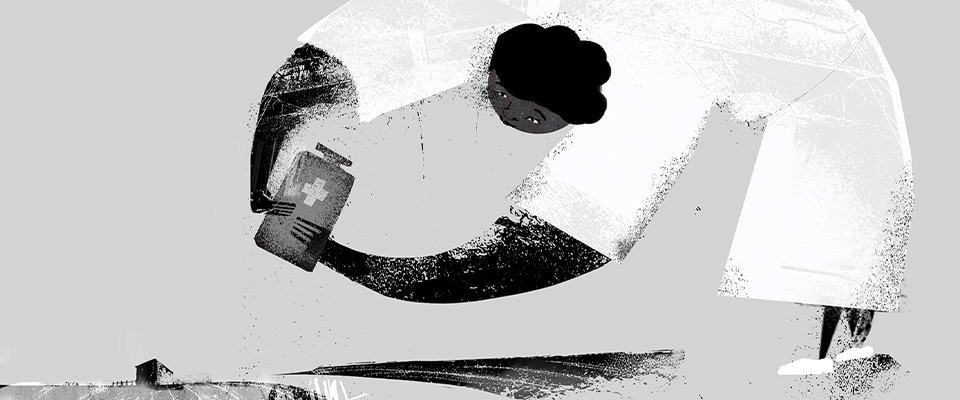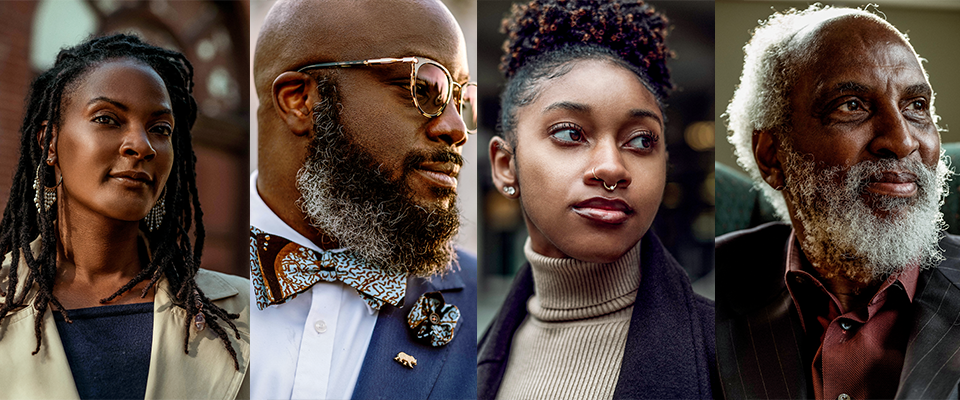“Since I’ve gotten old, I have wondered how I did all the things that I did then,” Ida Louise Jackson reflected in 1984 at the age of 82. Jackson participated in some of the major movements of the 20th century: the Great Migration, school desegregation, the battles for equitable education and health, and the Civil Rights Movement. Some of her earliest activism began at Berkeley when she organized the second Black sorority on the campus (shortly after the founding of AKA’s rival Delta Sigma Theta). She also ran an education and health program for rural Black Southerners along with her sorority sisters, joined the board of the NAACP when she was 19, and became the first Black woman to teach in Oakland public schools.
Born in Vicksburg, Mississippi, in 1902, Jackson was the only girl in a family of seven brothers. Her father, Pompey Jackson, was a minister, carpenter, and farmer, and her mother, Nellie, was a homemaker. When her father died, the family set its sights on California. “My mother had always wanted to come to California,” Jackson recalled. “She was interested in everything in California.” The Jackson household was a stronghold of resistance to oppression, and as she explained, “We were taught to protect ourselves and rather die than be humiliated by being a coward and not standing up for our rights.”
In 1984 and again in 1985, Jackson returned to Berkeley to tell her life’s story in interviews with Gabrielle Morris, then program director for the University of California Black Alumni Project. What follows are annotated excerpts from those interviews, beginning with Jackson’s reflections on her upbringing:

My parents wanted each of us to get an education as they had little or no opportunity, and my friends were going to Rust1. My mother always said I could go to school as long as I wanted to get an education, but when I wanted to “court”—to use the expression we used then—when I wanted to court, then her help, that help for my education would end, because “boys and books” didn’t mix.
Neither [of my parents] finished high school. How far they went, I don’t know. But anyway, I’ve often thought how much better it would have been if my mother had had the opportunity that I had.
I was taught to express myself, all of us were. My father is responsible for our thinking that education would do so much for us, and I thought that too. He just really believed that if Blacks were educated, better educated, if they had a chance for education, that would solve the racial problem; they’d have a chance to get ahead. As I see it now, I must have been pretty militant. I’m pretty sure if I’d been a man and living in the South I would not have survived.
As Jackson explained, leaving the South was a matter of survival. Racist violence wasn’t uncommon in the region, and that, coupled with the lessons her family instilled in their children, made the South unsafe for all of them—particularly the boys. “My mother realized that due to that kind of … teaching, my brothers should leave the South.” Her brothers went ahead to California while Ida finished school.
Jackson’s parents stressed the idea that the system could take everything away from you—except your education. Ida was an avid student, finishing high school in Vicksburg and then heading to Rust College in Holly Springs, Mississippi, when she was 14, before transferring to New Orleans University (now Dillard). It was while she was at school in Louisiana that Ida and her mother joined the rest of the family in Oakland.
[My brothers] told my mother to bring me on out here, that I could get a better education in California free than she was paying for my going to the boarding schools in the South. I loved to read, and I had a natural curiosity. And I was tremendously interested in the University of California, because my brother had pictured it to us. And the fact that you could get an education free. The schools that I had attended, the Black colleges that I had seen, however beautiful, they didn’t come up to anything like the University of California. So I said, “Well, I wonder if I can handle this.” I had a conversation with myself. I wasn’t sure what I could do. As I think back on it now, I wonder about myself and some of the ideas I had because I’ve always been a challenge to myself, if you know what I mean. I said, “I dare you to try this.”
Much of Oakland’s Black community didn’t arrive until the Second Great Migration, the period after World War II, which saw 1.5 million Black Americans leave the South. In 1852, there were a mere 14 Black residents, but as the transcontinental railroad was completed in 1869, that number grew steadily, reaching around 5,000 in 1920. Many Black residents, including several of Jackson’s brothers, found employment on the railroads as maids, cooks, railway porters, and waiters. “There were very few Negro or Black people in Oakland in 1918,” Jackson told Morris. “We were conspicuous. If a Negro was downtown, you would likely see him.” Those small numbers meant that there was a sense of mutual support within Oakland’s Black community. When they first arrived, the Jackson family stayed with another Black family they knew. “Most settled in West Oakland because they knew somebody there, and they found a place with these friends until they could rent or buy places of their own,” Jackson explained. They also found community in the local Methodist church. “That first Sunday we went to church, we were introduced,” she recalled. “We met several of the leading people in the community there.”

When Jackson arrived at Berkeley in 1918 she was one of the University’s 17 Black students. Many within this group were close. As Jackson explained, “Vivian [Marsh’s] house and my home were the only places that Black young students had to go because the others attending the University were rooming with people, and we had homes. So the social gatherings were at our two homes.”
Her classmates were, in many cases, just as remarkable as she was. Among some of the notable students were Marsh, an activist and founder of Berkeley’s Delta Sigma Theta chapter; Walter Gordon, an All-American athlete and Berkeley’s first Black student to receive a doctorate of law from Boalt Hall; and Ellis Knox, the first Black student to be awarded a doctorate, of any kind, on the West Coast.
At Berkeley, Jackson formed the University’s chapter of the Alpha Kappa Alpha sorority. Jackson, who learned about the sorority from a drama group she was in, was impressed by how many “outstanding women of the nation at the time in the field of education were members of Alpha Kappa Alpha,” and wanted to bring the organization to Berkeley.
Jackson later became the sorority’s regional director, organizing chapters throughout the Far West. She became the national president of the organization in 1934.

I am responsible for bringing Alpha Kappa Alpha sorority out, which is the first Black sorority in the nation, and first at the University of California. [S]ome of the famous Black women then, Dean Lucy Slowe2 and Maudelle Brown Bousfield3 … and several of the outstanding women of the nation at the time in the field of education were members of Alpha Kappa Alpha. So the majority of us decided we wanted to join AKA. This sorority required us to get the dean’s approval before they would accept our application. So I made an appointment to see Dean [Lucy] Stebbins.

Soon after we organized as a chapter of AKA sorority, we decided we wanted our picture in [the yearbook] the Blue and Gold, so we went up and paid the 45 dollars. Again, my folks had to get the money together. My brother Emmett helped us to get that. We each put in an amount and went up and paid it at the ASUC office, and they sent us to the photographer. We went down as a group and had our picture made. When the Blue and Gold came out, we weren’t in there. It just was a terrible thing.
We went to Dean Stebbins, and she couldn’t tell us anything about it, so we went to President [David P.] Barrows. And in each case, I became the spokesman of the group. I’ll never forget when we left Dean Stebbins’ office, I made an appointment to see President Barrows. We wanted to know why we did not appear in the Blue and Gold; we met the requirements, we had paid our fee and had our picture made, and why weren’t we in there? So he told us we “weren’t representative of the student body.” President Barrows told us that. Now when I said that, Irving Stone4 got me to withhold that remark in the interview I did with him because some of President Barrows’ descendants were connected with the University of California, and it might hurt their feelings; Ella Hagar, for one.

He told us we weren’t representative of the student body. That’s why our pictures didn’t appear, so there was nothing else we could do.
Despite being made to feel otherwise, Jackson decided it was her right to celebrate all that she’d achieved in her years on campus. For her, that meant attending her graduation and the events surrounding it. This would take bravery, something she’d never lacked. As she told Morris, “I do feel that it’s a good philosophy to have a certain amount of confidence in yourself; to be willing to tackle whatever interests you, because you get something out of it whether you win all the way or not. It’s a valuable experience to go into unknown territory to sort of prepare yourself for anything that follows.”
I remember when it came to senior week on the campus. There was another young woman who graduated at the time that I did, Oreathial Richardson. There were two or three Black men that graduated the same day. I remember the seniors were supposed to wear white and carry a white umbrella. I told Oreathial we should go. She said, “I wouldn’t go. Oh, I’m not going. They’ll snub you.” I said, “Well, we’ll be together.” She didn’t go. But I went. The group of Black students laughed at me for going alone in the line of marching senior women. I said, “I’m not concerned about what the other people think. I want to know what they know. I want to see these places. This is graduation time, and I want to participate in it and see what it’s like.” So I marched in the procession. Some of the Black students that were watching the procession yelled and laughed at me for participating in the march. They tried to make a picture of me walking along. I turned my back as they made the picture. Somewhere I have that picture. I recognized myself, but I doubt if others recognized me.
Jackson would claim another accomplishment after graduating in 1923—becoming the first Black woman certified to teach high school in the state. She worked as a home economics and English teacher in the El Centro school district. Black parents, whose children could not attend the all-white Central Union High School, insisted on having Black teachers at their school, East-Side High. Still, her heart was in Oakland, and she continued to apply for teaching jobs there with no success. She was finally given an opportunity, though it would take an intervention by the NAACP, and in 1924 she began working at Prescott School in West Oakland.
[A]pparently it was a deep-seated feeling that no Blacks should become teachers in the Oakland public schools, because there were very few Blacks in the schools and those that were there, were not being trained to further their education. [White people] never thought in terms of a Black being able to teach them anything. Maybe cooking. [laughs] We like seasoning, and maybe they thought we could teach them something there. But it wasn’t a part of the general consciousness. [O]n paper we were not supposed to be segregated here. We were supposed to get any job for which we were qualified. I asked a[n Oakland] native daughter why were they going South to teach, why didn’t they teach here[?] One said, “I couldn’t endure what you endured as a teacher in Oakland.” When I was teaching at Prescott in Oakland, I remember encouraging some of my more brilliant students to go on to college. And when they would go to the counselor that they had then, she would tell them, “Now, don’t think you can go into the teaching profession. Don’t think because Miss Jackson is teaching that there will be other Black teachers. So don’t plan a career teaching.”
Though Jackson had built a life in California, Black people in the rural South were never far from her mind. “I felt that if rural teachers—most Blacks lived in rural communities then—if the Black teachers were better prepared, they could inspire the youth to break the shackles.” A 1970 article in Ebony magazine on the nation’s legacy of school segregation noted that in the South “prejudice, discrimination and segregation set up a dual system, in which in most cases, the schools attended by Blacks were so inadequate that it was impossible for a child to get a decent education. To make matters worse, no attempt was made to see that a Black child attended school and most spent valuable school hours in the cotton and tobacco fields.”

Jackson organized her sorority sisters to form a summer training program for rural teachers. They taught the students in the morning and the teachers in the afternoon. They held the summer school for two years, and then added a rural health project that would continue for another six years.
The Mississippi Health Project, as it would be known, was started by Jackson and Dr. Dorothy Boulding Ferebee. As Ferebee biographer Diane Kiesel explains, the volunteer nurses, “drove thousands of miles of unpaved roads through the Deep South with no public places to eat, sleep, or use the bathroom. It was tough, dangerous, uncertain work.” But by the project’s end, the volunteers had immunized nearly 15,000 children against diphtheria and smallpox, and provided thousands of adults with treatments, health screenings, and health education. Of her decision to travel to the South to embark on this project, Jackson said, “Who else would be crazy enough to go there?”
As soon as I was elected president [of the AKA sorority], I sent out a call for volunteer teachers to go in the South and teach at the summer school. It was a plan of my own. I didn’t dare take it up with the national [AKA sorority] at the time because everybody wasn’t seeing things as I saw them. I sent out a circular letter when I became Basileus (national president). I guess I got about 30 responses, but I could only take about eight.
All of my teachers were members of the sorority. It was published as Alpha Kappa Alpha summer school for rural teachers. It was a school for Blacks in the rural South. And it was almost as bad as it was during the slavery days, so I met [Dr. Arenia C. Mallory, president of Saints Industrial School, a church-run school in Mississippi] and made an appointment to talk with her. She presented such a gloomy picture of conditions that I visited her campus, I think it was ’33, on my Christmas vacation. I saw enough in visiting the local nearby towns and plantations that made me feel that we should try to do something about it.

When we conducted the school, we saw the children were emaciated. We visited the homes, and they had routine diets, you know. I’m saying “you know,” and yet you may not know5. We found that in some instances the cotton was grown right up to the door and they didn’t have space for a garden if they had wanted to have one, in many instances. Now, in some places where people owned a little land, they had gardens. We added the nutrition class because these people needed to learn how to use the things that were available, that they could grow. Mrs. [Eleanor] Roosevelt helped us. She invited us to the White House. We met her there. She was very interested. I don’t remember how it came to her attention. I was invited to the lighting of the Christmas tree. I got an invitation to come to Washington to the lighting of the Christmas tree there during the Roosevelt administration. That was the first time I got near Washington.
Her father’s words about the power of education always seemed to echo in Jackson’s mind. For her, there was always another level to reach when it came to education. She would continue her work by completing her master’s at Berkeley and doctorate coursework at Columbia. Despite adding more qualifications, she never held an administrative position in Oakland and was repeatedly told that the public schools there “weren’t ready for a Black principal.” Eager to get administrative experience, she took a position as the dean of women at Tuskegee University, the historically Black college in Alabama. She continued her work in educational equity for Black students, and founded or helped steward several organizations devoted to those goals. Finally, after 30 years of teaching and being frustrated by the lack of advancement possibilities in Oakland public schools, she purchased a 1,280-acre ranch in Mendocino with one of her brothers. She lived at the ranch for nearly 20 years before returning to Oakland in 1973. She later donated hundreds of acres of that land to the University and asked “that the proceeds be used toward graduate fellowships for Black students working on their dissertations at Berkeley.” She continued her work toward educational equity and opportunities until her death in 1996. She looked back on her time at Cal and in Oakland with both fondness and pain.
I’ve been a life member of the alumni association for years. I don’t remember when I joined. I was a member of the association a long time before I took out life membership. It had no program into which a Negro, a Black person would fit. You see, California hasn’t proved to be the Mecca that most of us thought it was. To put it roughly, the Black could go to the shows and sit anywhere they wanted to. He was paying his money for that. But when it came to equality of opportunity in employment, jobs above the average, the racial factor entered. It has never disappeared.
Ashawnta Jackson is a freelance writer living in Brooklyn.
***Correction: A previous version of this story incorrectly stated that the Rho Chapter of Alpha Kappa Alpha was “the first Black sorority in the western United States.” The Berkeley chapter of rival Black sorority Delta Sigma Theta was founded just prior to AKA.
From the Fall 2020 issue of California.





















